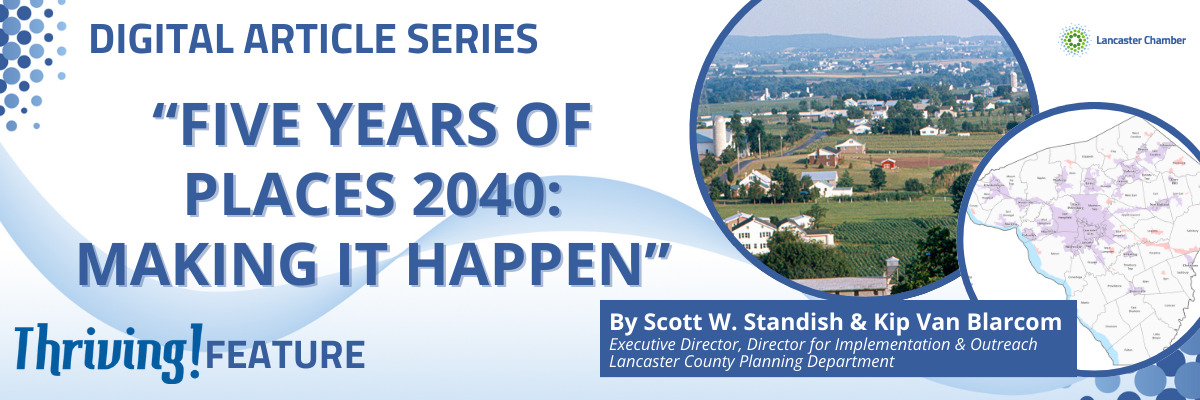By Scott W. Standish, Executive Director & Kip Van Blarcom, Director for Implementation & Outreach, Lancaster County Planning Department
A feature piece from our Spring 2024 issue of the Lancaster Thriving Publication.
What Is places2040?
Just over five years ago, the Lancaster County Board of Commissioners adopted places2040 as the comprehensive plan for Lancaster County. This plan is a road map that leads us toward the future we all want to see.
Although the Lancaster County Planning Department produced the plan, it’s a plan for the entire community, and reflects years of dialogue and engagement with public, private, and nonprofit partners. Local residents, municipal officials, utility authorities, and school districts helped to shape its goals. The department also worked with regional, countywide, and city organizations we call our “Partners for Place.” The Lancaster Chamber is among them.
Traditionally, comprehensive plans focus on categories like housing, economic development, and agriculture. Places2040 takes a more holistic approach, because each of these issues affects the others. We can’t solve land-use and transportation challenges in isolation. Likewise, we’ve learned that no single organization, municipality, or individual can address any of these issues on their own.
That’s why places2040 focuses on five integrated concepts called “big ideas.” Their purpose is to help Lancaster County remain a great place in the future. The five big ideas are:
- Creating Great Places
- Connecting People, Place, & Opportunity
- Taking Care of What We Have
- Growing Responsibly
- Thinking Beyond Boundaries
The most crucial aspect of the plan is its emphasis on “Thinking Beyond Boundaries.” It’s not just one of the big ideas, but the tagline for the entire plan! Rather than trying to solve planning challenges within each municipality or school district, the plan looks at the county the way a visitor would. It encourages us to see communities, corridors, and landscapes as a whole, rather than splitting them up in traditional ways.
Making the Vision a Reality
So, five years on, how are we doing? The good news is, the vision in places2040 is becoming a reality. We’re seeing more cooperation and dialogue about what we all agree on – protecting and enhancing Lancaster County’s unique sense of place.
Over the past five years, we’ve made some serious progress in implementing the plan’s big ideas. We’ve worked with our planning partners to make places2040 a model for collaborative planning. We’re also taking a new look at the countywide growth area boundaries that were established over 30 years ago. Finally, we’re facilitating “small-area” plans that reflect our place-based planning strategy.
Regional Planning
To facilitate collaborative planning, we’ve worked with our municipal partners to develop and adopt several regional (multi-municipal) comprehensive plans consistent with places2040 (see map of regional plans). This effort has helped local governments save significant time and money. The first plan of this type was the Southern Lancaster County Comprehensive Plan completed in 2022. Most of the region’s municipalities adopted this plan, a testament to local leaders who took a proactive role in the process.
We completed the Comprehensive Plan for the Cocalico Region in 2023, and Northwestern Lancaster County is poised to adopt a new plan this year. We’ve also initiated similar plans in the Manheim Central Region, the Pequea Valley Region, and Eastern Lancaster County.
Growth Area Recalibration
The second major effort to implement places2040 focuses on recalibrating growth area boundaries. Urban and Village Growth Areas (see growth area map) include and surround Lancaster City, the county’s boroughs, and larger villages. Through our regional meetings with municipal officials, we’ve presented countywide analysis of buildable land, potential redevelopment areas, and other factors. That data will help all of us make more informed decisions about potential changes in these boundaries.
Recent population projections show the county’s growth rate is slowing, so it appears we’ll have enough land within growth areas to accommodate the population expected by 2040. However, one acute need may inspire a conversation about potential boundary changes. The lack of industrial-zoned land makes it difficult for many Lancaster County businesses to expand. If parcels adjacent to existing boundaries are well suited for industrial use – and infrastructure can be provided – it might make sense to include some of this land in growth areas.
Development Pattern
While the location of growth is a key factor in growth management, so is the development pattern. If we’re successful, we’ll make efficient use of the buildable land remaining within growth areas, while at the same time encouraging the redevelopment of underutilized land. It’s especially important to study where development/redevelopment opportunities intersect with priority transportation corridors and existing “nodes” of activity.
Facilitating positive change in these locations could make a big impact on the issues we’re facing with housing, transportation, and industrial development. With more housing types, mixed-use development, and road and trail connections, our urban areas could become more vibrant places to live, work, and do business.
We’ve taken that same approach with small-area plans highlighting places with untapped potential to bring jobs, housing, and transit together in new ways. The Lancaster Train Station Small-Area Plan and the Bridgeport Crossroads Transportation & Land Use Study demonstrate how we can accommodate future growth more efficiently and effectively. We’re also working to provide new connections such as the Lancaster Heritage Pathway, a multi-use trail that will eventually link the Park City area with Leola.
Why We Plan
Lancaster County is a growing, changing, and dynamic place. The goal of places2040 and the work of Lancaster County Planning – both the Commission and the Department – is to manage growth in a way that protects what we love while helping to sustain our economy over the long term. If we want to retain the characteristics that make Lancaster County a unique and special place, we need to plan ahead!
not secure

